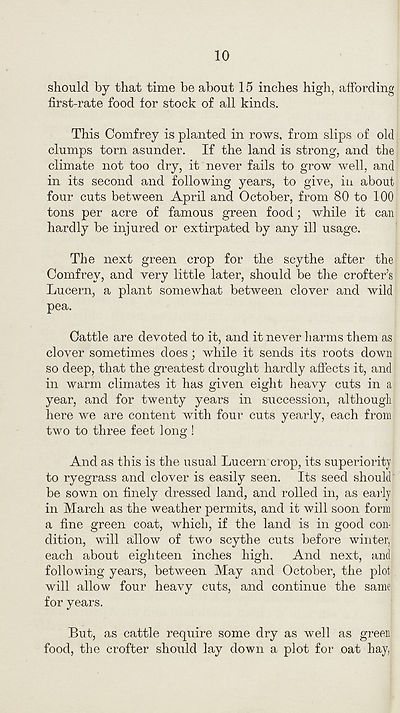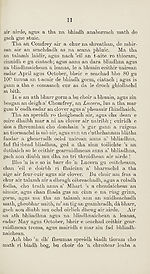Download files
Complete book:
Individual page:
Thumbnail gallery: Grid view | List view

10
should by that time be about 15 inches high, affording
first-rate food for stock of all kinds.
This Comfrey is planted in rows, from slips of old
clumps torn asunder. If the land is strong, and the
climate not too dry, it never fails to grow well, and
in its second and following years, to give, in about
four cuts between April and October, from 80 to 100
tons per acre of famous green food; while it can
hardly be injured or extirpated by any ill usage.
The next green crop for the scythe after the
Oomfrey, and very little later, should be the crofter’s
Lucern, a plant somewhat between clover and wild
pea.
Cattle are devoted to it, and it never harms them as
clover sometimes does; while it sends its roots down
so deep, that the greatest drought hardly affects it, and
in warm climates it has given eight heavy cuts in a
year, and for twenty years in succession, although
here we are content with four cuts yearly, each from
two to three feet long !
And as this is the usual Lucern crop, its superiority
to ryegrass and clover is easily seen. Its seed should'
be sown on finely dressed land, and rolled in, as early
in March as the weather permits, and it will soon form
a fine green coat, which, if the land is in good con¬
dition, will allow of two scythe cuts before winter,
each about eighteen inches high. And next, and
following years, between May and October, the plot
will allow four heavy cuts, and continue the same
for years.
But, as cattle require some dry as well as green
food, the crofter should lay down a plot for oat hay,
should by that time be about 15 inches high, affording
first-rate food for stock of all kinds.
This Comfrey is planted in rows, from slips of old
clumps torn asunder. If the land is strong, and the
climate not too dry, it never fails to grow well, and
in its second and following years, to give, in about
four cuts between April and October, from 80 to 100
tons per acre of famous green food; while it can
hardly be injured or extirpated by any ill usage.
The next green crop for the scythe after the
Oomfrey, and very little later, should be the crofter’s
Lucern, a plant somewhat between clover and wild
pea.
Cattle are devoted to it, and it never harms them as
clover sometimes does; while it sends its roots down
so deep, that the greatest drought hardly affects it, and
in warm climates it has given eight heavy cuts in a
year, and for twenty years in succession, although
here we are content with four cuts yearly, each from
two to three feet long !
And as this is the usual Lucern crop, its superiority
to ryegrass and clover is easily seen. Its seed should'
be sown on finely dressed land, and rolled in, as early
in March as the weather permits, and it will soon form
a fine green coat, which, if the land is in good con¬
dition, will allow of two scythe cuts before winter,
each about eighteen inches high. And next, and
following years, between May and October, the plot
will allow four heavy cuts, and continue the same
for years.
But, as cattle require some dry as well as green
food, the crofter should lay down a plot for oat hay,
Set display mode to:
![]() Universal Viewer |
Universal Viewer | ![]() Mirador |
Large image | Transcription
Mirador |
Large image | Transcription
Images and transcriptions on this page, including medium image downloads, may be used under the Creative Commons Attribution 4.0 International Licence unless otherwise stated. ![]()
| Rare items in Gaelic > Books and other items printed in Gaelic from 1871 to 1900 > Croft cultivation > (16) |
|---|
| Permanent URL | https://digital.nls.uk/109888510 |
|---|
| Description | Out-of-copyright books printed in Gaelic between 1631 and 1900. Also some pamphlets and chapbooks. Includes poetry and songs, religious books such as catechisms and hymns, and different editions of the Bible and the Psalms. Also includes the second book ever published in Gaelic in 1631. |
|---|

